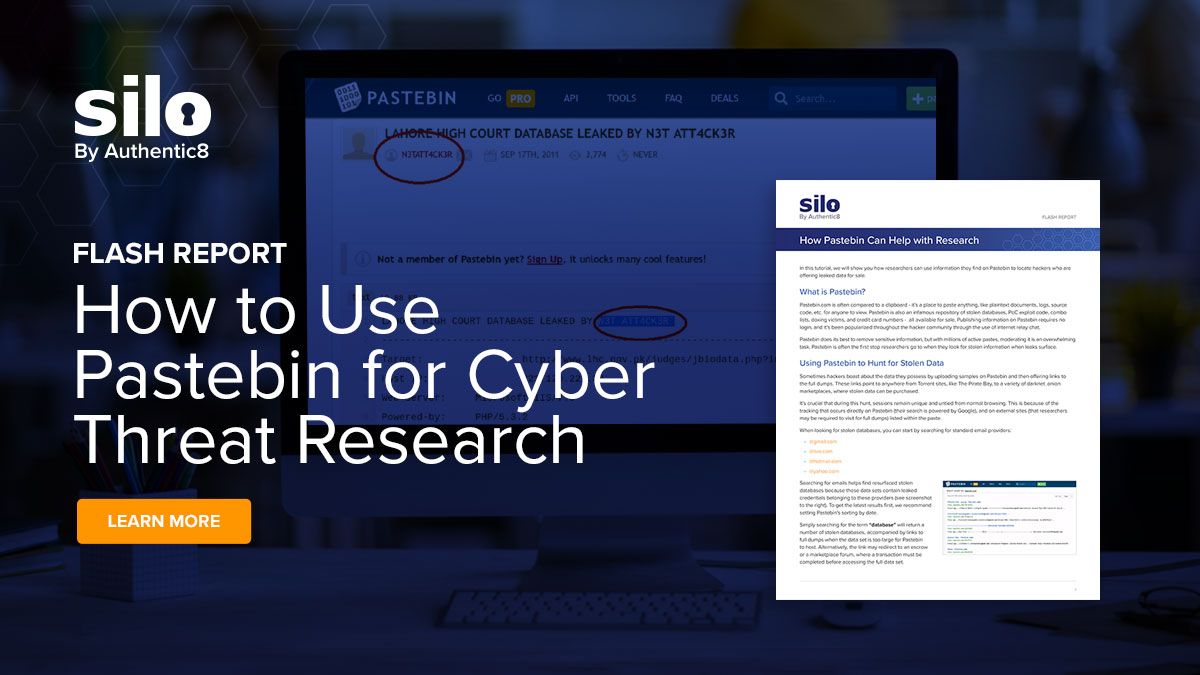Learn what Pastebin is and how cyberthreat intelligence researchers use it to detect data leaks, monitor threat activity, and uncover malware operations across paste sites.
Pastebin is a free online text storage service used to share code, logs, and plaintext files publicly or privately. Developers use it to collaborate, while cybersecurity analysts monitor it for leaked credentials and data breaches. It’s often called the “clipboard of the web.”
In the world of open-source intelligence (OSINT), paste sites (Pastebin, Ghostbin, Hastebin, Rentry, et al.) are a bit of a paradox. On the surface, these are simple text-sharing sites, a digital scratchpad for developers pasting code. But in the hands of threat actors, these sites are staging grounds for leaks, malware, and stolen credentials. For researchers, this paradox is precisely what makes paste sites so valuable. They're messy, volatile, and risky…but also rich with insight.
What is Pastebin used for?
In cybersecurity, analysts often monitor Pastebin for leaked credentials, source code, or sensitive data posted by threat actors. While developers use it for legitimate collaboration, Pastebin can also serve as a repository for data exfiltration or information disclosure, making it a valuable source for threat intelligence collection and dark web monitoring.
As useful as Pastebin is for sharing and collaborating online, it also has a dark side. The Register called it “the remote backdoor server for the cheap and lazy.” The service has become infamous as a repository of leaked or stolen databases, Proof of Concept (PoC) exploit code, combo lists, doxing victim dossiers, and credit card numbers—all on sale or even offered for free.
Publishing information on Pastebin requires no login, and it’s been popularized throughout the hacker community through the use of internet relay chat (IRC). While the Pastebin team is serious about removing sensitive information, it has reached its limits. With millions of active pastes, moderating the service has become an overwhelming task.
This means that threat intelligence professionals need to keep an eye on the service. They should know what to do next if and when their employer or client is affected by a data dump on Pastebin.

→ Learn how to use Pastebin for cyberthreat intelligence research in our flash report.
Top paste sites for OSINT research
While Pastebin is the most well-known of its kind, it’s just one node in a broader ecosystem of paste sites. Many of these paste sites offer less moderation, more anonymity, and shorter content lifespans. These sites all serve similar functions but differ in critical ways that matter to OSINT practitioners: visibility, retention, encryption, and discoverability.
Here’s a breakdown of some of the most prominent paste sites:
| Platform | Anonymity | Public/private options | Retention control | Moderation level | Notable use cases |
| Pastebin | Medium | Yes | Yes | Moderate | Credential leaks, C2 commands, breach teasers |
| Ghostbin | High | Yes | Yes | Low | Encrypted pastes, hacktivist manifestos |
| Hastebin | Low | No (mostly public) | Minimal | Very Low | Temporary code sharing, throwaway notes |
| Rentry | Medium | Yes | Yes | Low | Long-form posts, operational instructions |
| 0bin | High | No (fully encrypted) | Yes | None | Encrypted payload drops, privacy-focused use |
| Paste.ee | Medium | Yes | Yes | Moderate | API-focused posting, structured logs |
Each of these platforms presents different operational trade-offs. Ghostbin and 0bin, for example, prioritize user privacy through client-side encryption and minimal tracking to make attribution harder for both defenders and adversaries. Others, like Hastebin, are designed for simplicity and speed, making them favored for one-time drops or temporary notes. But they often get abused for hosting unmoderated or malicious content.
Rentry is increasingly used to host structured narratives: actor manifestos, operational manuals, or aggregated links to other drops. Its Markdown support makes it attractive for long-form content that would look unwieldy on Pastebin or Hastebin.
This ecosystem fragmentation introduces real challenges for researchers, as each site comes with different indexing, scraping, and takedown rules. Some sites allow public search, while others rely on obscurity or encryption. And yet, threat actors often cross-post the same content across multiple platforms to avoid takedowns or increase exposure.
As a result, OSINT analysts can’t afford to monitor just one site. It’s a distributed threat surface, and staying ahead of it requires tools, workflows, and operational security that scale across multiple paste platforms. The insights are out there—but only if you're looking in the right places at the right times.
Why monitor paste sites?
There are three primary reasons researchers keep a close eye on paste sites: early breach detection, threat actor profiling, and command and control (C2)/malware discovery.
Early breach detection
Pastebin is often used as a drop zone for credential leaks, source code, and sample data from data breaches. It’s not uncommon for hackers to post a small slice of stolen data there as a teaser to sell the full dataset or as part of a hacktivist operation. Monitoring these sites lets organizations detect breaches before the full impact lands in public view or on dark web forums. In some cases, the first sign of compromise comes not from internal alerts, but from a Pastebin post circulating among threat intel analysts.
Threat actor profiling
The unstructured, low-effort nature of paste sites turns them into behavioral playgrounds. Reused handles, repeated language, or specific formatting choices can help analysts link pastes to specific actor personas or threat groups. Sometimes, the way something is pasted says as much about the threat actors as the pasted content itself. Researchers have documented how certain ransomware affiliates or criminal groups use paste sites as informal bulletin boards or callouts for attention.
Command and control (C2) / malware discovery
Some malware families use Pastebin as an improvised command and control (C2) infrastructure. Malware authors will drop encrypted payloads or command strings into public pastes that infected machines can retrieve dynamically. This makes their infrastructure more flexible and harder to blacklist, especially since Pastebin is a widely trusted domain.
Paste site risks
Unfortunately, the utility of these paste sites for OSINT researchers comes with baggage, with the three categories of risk that matter to researchers and defenders alike being malicious code and links, accidental exposure, and bypassing security filters.
→ Looking for a safe way to analyze paste sites? Check out Silo, a fully isolated, anonymous, and secure platform for conducting all forms of digital investigations.
Malicious code and links
Some pastes contain obfuscated JavaScript, PowerShell commands, or embedded URLs to malware. It’s not hard to stumble across credential phishing kits, shell scripts for lateral movement, or working exploits. Click the wrong thing—or run it without sandboxing—and even the most experienced researcher can accidently compromise their own system…or themselves.
Accidental exposure
Beyond being a hacker haven, sites like Pastebin are also where developers and sysadmins accidentally leak secrets. Misconfigured logging scripts or careless clipboard copies can result in the exposure of API keys, session tokens, or even full database dumps. This unintentional exposure is a liability for organizations…and a goldmine for threat actors.
Bypassing security filters
Because Pastebin is a legitimate site, attackers use it to bypass filters that would normally block suspicious domains. Malicious links or payloads hosted on Pastebin are less likely to trigger alerts from endpoint security tools or proxy servers, making these platforms attractive delivery vehicles for phishing, C2, or credential harvesting.
The cyberthreat intelligence researcher’s dilemma with paste sites
Ignoring paste sites is a dangerous misstep, yet interacting with them directly can be just as dangerous. That’s the dilemma. Even viewing a paste can expose a researcher’s IP address, fingerprint, or session metadata, which can alert adversaries and create the risk of attribution. Downloading files from pastes? Unless you’re working from an isolated environment, that’s even worse!
Frankly, this is why I’ve been such a fan of Silo for so many years. The platform creates a disposable, cloud-based browser session with full isolation, attribution control, and audit trails. I can investigate sketchy pastes without contaminating my environment or revealing myself. I’m even protected if I get sloppy, which is an occupational hazard of working a lot of diverse projects at odd hours.
If I’m poking around in the same spaces where actors are leaking credentials and malware, I consider stealth and containment to be non-negotiables…and I’m not setting up virtual machines or a giant home lab to get it done because—frankly—I don’t have the time, energy, skills, or resources for all of that.
If you’re not monitoring paste sites as part of your ongoing OSINT practices, you’re missing the pulse of the internet’s underbelly. While noisy and ephemeral, Pastebin and its cousins offer a rare look into how threat actors signal, experiment, and occasionally slip up. Yes, it’s risky to be in these places…but that’s why it’s valuable.
The best researchers don’t avoid the mess. They find ways to navigate safely within the mess. That starts with understanding the dual nature of paste sites—and using the right tools to explore them without getting burned.
What is Pastebin FAQs
What is Pastebin used for?
Pastebin is used for sharing text, code, and logs publicly or privately. In cybersecurity, analysts track Pastebin for leaked credentials, data dumps, and malware communications to gather threat intelligence insights.
How do cyber analysts use Pastebin?
Cyber analysts monitor Pastebin and other paste sites to detect data breaches, credential leaks, and command-and-control activity. Automated tools and isolated browsers help analysts safely investigate these pastes.
Is Pastebin safe to use?
Pastebin is safe for everyday users but can host malicious links or leaked data. Analysts should only access it through isolated browser environments to prevent exposure and maintain anonymity.
How do you search Pastebin?
You can search Pastebin by using its built-in search bar (available to registered users) or external OSINT tools that index public pastes. Cyber analysts often rely on advanced Google queries (like site:pastebin.com "keyword") or specialized monitoring platforms to locate leaked credentials, malware code, or breach data quickly and safely.
Tags Threat intelligence
